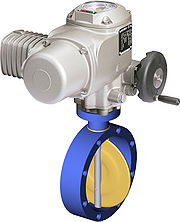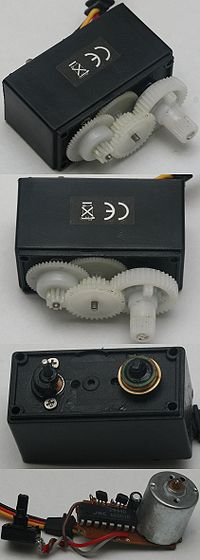
Rotary actuator
Encyclopedia

Actuator
An actuator is a type of motor for moving or controlling a mechanism or system. It is operated by a source of energy, usually in the form of an electric current, hydraulic fluid pressure or pneumatic pressure, and converts that energy into some kind of motion. An actuator is the mechanism by which...
that produces a rotary
Rotation
A rotation is a circular movement of an object around a center of rotation. A three-dimensional object rotates always around an imaginary line called a rotation axis. If the axis is within the body, and passes through its center of mass the body is said to rotate upon itself, or spin. A rotation...
motion or torque
Torque
Torque, moment or moment of force , is the tendency of a force to rotate an object about an axis, fulcrum, or pivot. Just as a force is a push or a pull, a torque can be thought of as a twist....
.
The simplest actuator is purely mechanical, where linear motion in one direction gives rise to rotation. The most common actuators though are electrically powered. Other actuators may be powered by pneumatic or hydraulic power, or may use energy stored internally through springs.
The motion produced by an actuator may be either continuous rotation, as for an electric motor
Electric motor
An electric motor converts electrical energy into mechanical energy.Most electric motors operate through the interaction of magnetic fields and current-carrying conductors to generate force...
, or movement to a fixed angular position as for servo
Servo
Servo may refer to:* Servomechanism, or servo, a device used to provide control of a desired operation through the use of feedback** Servo , a small, cheap, mass-produced actuator used for radio control and small robotics** Servo bandwidth...
s and stepper motor
Stepper motor
A stepper motor is a brushless, electric motor that can divide a full rotation into a large number of steps. The motor's position can be controlled precisely without any feedback mechanism , as long as the motor is carefully sized to the application...
s. A further form, the torque motor, does not necessarily produce any rotation but merely generates a precise torque which then either causes rotation, or is balanced by some opposing torque.
Stepper motors
Stepper motors are a form of electric motor that has the ability to move in discrete steps of a fixed size. This can be used either to produce continuous rotation at a controlled speed or to move by a controlled angular amount. If the stepper is combined with either a position encoderRotary encoder
A rotary encoder, also called a shaft encoder, is an electro-mechanical device that converts the angular position or motion of a shaft or axle to an analog or digital code. The output of incremental encoders provides information about the motion of the shaft which is typically further processed...
or at least a single datum sensor at the zero position, it is possible to move the motor to any angular position and so to act as a rotary actuator.
Servomotors

Rotary encoder
A rotary encoder, also called a shaft encoder, is an electro-mechanical device that converts the angular position or motion of a shaft or axle to an analog or digital code. The output of incremental encoders provides information about the motion of the shaft which is typically further processed...
that identifies the position of the output shaft and an inbuilt control system. The input control signal to the servo indicates the desired output position. Any difference between the position commanded and the position of the encoder gives rise to an error signal that causes the motor and geartrain to rotate until the encoder reflects a position matching that commanded.
This type of servo is widely used for radio-controlled model
Radio-controlled model
A radio-controlled model is a model that is steerable with the use of radio control. All types of vehicles imaginable have had RC systems installed in them, including cars, boats, planes, and even helicopters and scale railway locomotives....
s.
Other types
A recent, and novel, form of ultra-lightweight actuator uses memory wire. As a current is applied, the wire is heated above its transition temperature and so changes shape, applying a torque to the output shaft. When power is removed, the wire cools and returns to its earlier shape.Fluid power actuators
Both hydraulic and pneumatic power may be used to drive an actuator, usually the larger and more powerful types. As their internal construction is generally similar (in principle, if not in size) they are often considered together as fluid power actuators. Fluid power actuators are of two common forms: those where a linear piston and cylinder mechanism is geared to produce rotation (illustrated), and those where a rotating asymmetrical vane swings through a cylinder of two different radii. The differential pressure between the two sides of the vane gives rise to an unbalanced force and thus a torque on the output shaft. Vane actuators require a number of sliding seals and the joins between these seals have tended to cause more problems with leakage than for the piston and cylinder type.See also
- RotorkRotorkRotork plc is a British-based manufacturing company. It is listed on the London Stock Exchange and is a constituent of the FTSE 250 Index.-History:...
Vacuum actuators
Where a supply of vacuumVacuum
In everyday usage, vacuum is a volume of space that is essentially empty of matter, such that its gaseous pressure is much less than atmospheric pressure. The word comes from the Latin term for "empty". A perfect vacuum would be one with no particles in it at all, which is impossible to achieve in...
is available, but not pneumatic power, rotary actuators have even been made to work from vacuum power. The only common instance of these was for early automatic windscreen wiper
Windscreen wiper
A windscreen wiper or windshield wiper is a device used to remove rain and debris from a windscreen or windshield. Almost all motor vehicles, including trains, aircraft and watercraft, are equipped with such wipers, which are usually a legal requirement.A wiper generally consists of an arm,...
s on cars up until around 1960. These used the manifold vacuum
Manifold vacuum
Manifold vacuum, or engine vacuum in an internal combustion engine is the difference in air pressure between the engine's intake manifold and Earth's atmosphere....
of a petrol engine to work a quarter-turn oscillating vane actuator. Such windscreen wipers worked adequately when the engine was running under light load, but they were notorious that when working hard at top speed or climbing a hill, the manifold vacuum was reduced and the wipers slowed to a crawl.
Applications
Rotary actuators are used in a vast range of applications. These require actuators of all sizes, power and operating speed. These can range from zero power actuatorsZero power actuators are those, such as display gauges, that do not deliver a tangible output torque that are only used as display devices, such as air core gaugeAir core gauge
An air core gauge is a specific type of rotary actuator in an analog display gauge that allows an indicator to rotate a full 360 degrees. It is used in gauges and displays, most commonly automotive instrument clusters....
s. Others include valve actuators that operate pipeline and process valves in the petrochemical industry, through to actuators for large civil engineering projects such as sluice gates and dams.

